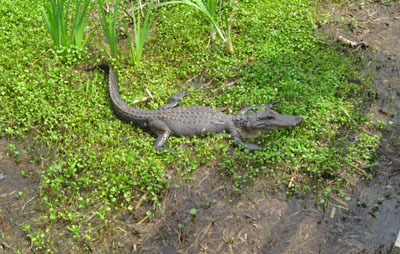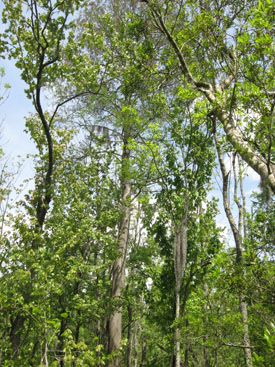
Ranger-guided walk reveals Barataria ‘gem’
MARRERO, La. — The wetlands at Barataria Preserve are rich in natural resources and home to abundant wildlife and plant life. Despite the beauty of the preserve, it remains somewhat of a hidden secret among the national parks.
“It’s the small units like this that people don’t know about that are generally the gems,” said Park Ranger Jim MacDonald, who has been working at Barataria for 1½ years.
While parks such as Yosemite and the Great Smoky Mountains are visited by millions of people each year, Barataria Preserve averages around 30,000 visitors per year. This means hiking and canoeing trails are less crowded, so nature can be appreciated with fewer distractions.
| Click on the video at right to see an audio slide show about Barataria Preserve’s wildlife photographed and narrated by writer Lauren Shepherd. |
The warm, humid weather may play a role in the number of visitors who come to the park. The most popular times to visit are in late fall and in the spring during March and April.
Barataria, one of several sites that comprise Jean Lafitte National Historical Park and Preserve, offers a variety of free programs each month, from canoe treks at each full moon to programs about the mysterious life of namesake pirate Jean Lafitte.
Ranger-guided walks are offered every day at 10 a.m. and 2 p.m., except for Christmas Day and, of course, Mardi Gras.
The group I traveled with arrived at the preserve around 12:30 p.m., which meant we had enough time to walk the two short trails behind the visitor center before the start of the 2 p.m. tour.
The walk began at the entrance of Bayou Coquille Trail, which is said to offer the best views of wildlife and wildflowers at the preserve. The trail is built on a boardwalk, so it is elevated and easily accessible.
Ranger MacDonald was our guide for the walk and it was clear from the start that he wanted everyone to enjoy the journey without any negative consequences.
 |
At left, two University of Miami students and professor Randy Stano walk on the brardwalk behind the visitor’s center at Barataria (Photos by Lauren Shepherd). |
“See that vine right there?” MacDonald asked, pointing at a nearby plant.
“That’s poison ivy. Memorize it and avoid it. Not everyone is allergic to it, but if you aren’t sure, today is not the day to find out,” he said.
With this knowledge in mind, we walked a bit further. MacDonald told us that until a few years ago, the stunning wild iris flowers attracted many visitors.
Unfortunately, hurricanes Rita and Katrina triggered an invasion of salt-water from the Gulf. When the salt water mixed with fresh water, few of the flowers survived.
The freezes this past winter caused a later blooming season for most wildflowers at the preserve. Still, the early bloomers sprinkled bursts of color among the vegetation.
A few minutes into the walk, the sound of “whoo, whoo” was heard off in the distance. The group looked expectantly at MacDonald for an explanation of the sound.
 |
Lush vegetation covers the wetlands of Barataria. These wild mushrooms were seen along the Bayou Coquille Trail. |
The noise was identified as that of a Barred Owl. They are very common in the preserve and quite active during the day and at night.
One pressing issue at the preserve is how to deal with the state’s disappearing coastline. The wetlands in Louisiana account for at least 80 percent of wetlands losses in the continental U.S. each year.
There is no sediment moving into the marshes from the Mississippi River because levees have been constructed to contain the river. The land is not building up, so it naturally erodes.
The continued loss of the bayous, marshes and barrier islands that make up the wetlands would be devastating. The Louisiana wetlands produce or transport more than one-third of the nation’s oil and one-quarter of its natural gas. About 30 percent of the nation’s seafood comes from the wetlands. The abundant native wildlife and thriving plant life would completely deteriorate, our guide told us.
Wildlife we observed on the walk included the ribbon snake, banded water snake, butterflies, frogs, ibis, and alligators.
“I’ve seen all sorts of wildlife out here,” said Barbara Everett, a New Orleans resident.
“You’ll definitely see snakes,” she said.
| A Broad-Banded Water Snake poses for visitors walking through the Bayou Coquille Trail. |  |
Alligators could be seen all along the Bayou Coquille and Marsh Overlook Trail, and were often very close to the trail itself.
MacDonald told us that the alligators sometimes worry park visitors. There is little cause for concern though, as there has not been a single report of an alligator causing harm to a human in the history of the park.
It is illegal to feed the alligators, as the alligators may start to associate food with people. Clearly, the law is in place for good reason.
 |
A young alligator basks in the afternoon sun. |
Plant life at the preserve varies throughout the different parts of the wetlands.
The most common trees along the trails included dwarf palmettos, tupelos, live oak, cypress, and red maples. Vetch and dewberry flowers were growing among much of the vegetation.
 There aren’t enough rangers in the preserve to offer tours more than a few times per day, so Barataria now offers cell phone audio tours for people who wish to learn more about the area.
There aren’t enough rangers in the preserve to offer tours more than a few times per day, so Barataria now offers cell phone audio tours for people who wish to learn more about the area.
There are seven areas along the Bayou Coquille Trail where the visitor can call the phone number listed at the stop to hear recorded information related that particular section of the trail.
If You Go:
The address is 6588 Barataria Blvd., Marrero, La. The preserve is about a 30-minute drive from downtown New Orleans. The entrance is located 17 miles south of the city, in Marrero.
A 25-minute video about Creole culture and the history of the wetlands is offered in the visitor center upon request.
Bring bug spray, water, a camera and a good pair of shoes for walking.
Ranger-guided walks are offered at 10 a.m. and 2 p.m. daily.
The park is open from 9 a.m. to 5 p.m. daily, except for Christmas and Mardi Gras.

Comments are Closed